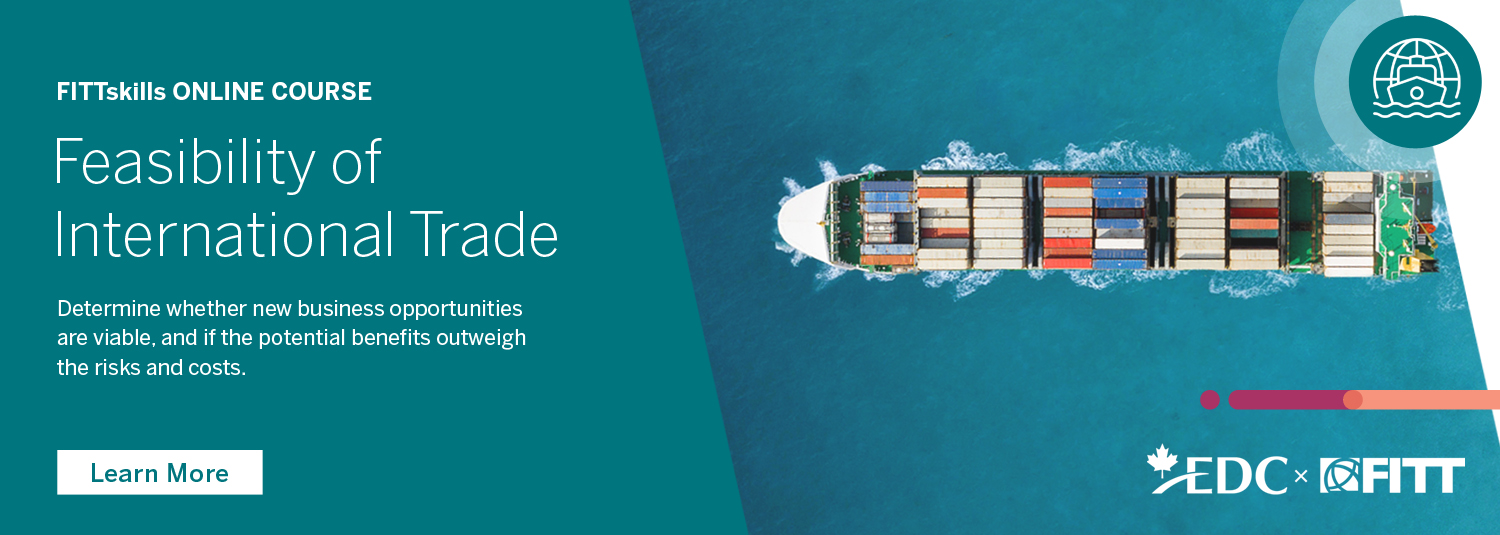
With all the potential in today’s global marketplace it can be a daunting task to find the right market to expand your business internationally. We know (statistics show) that companies who export make more money than those who only sell to their domestic market. But how do you narrow down potential markets from the entire world, to a particular geographic area, country and region?
Reviewing available data for different international markets allows organizations to assess which markets realistically fit with their overall strategic direction. This allows for selection of potential target markets where product and service alignment is evident and market entry is feasible. As detailed market research can be expensive, many experts suggest the process begin with a preliminary screening to assess basic alternatives and narrow the focus before proceeding to more comprehensive data collection.
Looking to determine if your new trade opportunities are viable? Check out the FITTskills Feasibility of International Trade online course!

While screening potential markets is often thought of when exporting products and services, it is also important for importers who are considering new suppliers of products and services.
Reflecting on the organization’s motivations, the identified research objectives and the research brief, researchers may need to narrow the list of potential target markets to ensure that available resources are spent wisely on further research and that useful market and competitive intelligence is obtained. This screening process should generally result in identifying a few target markets with high success potential for further investigation.
One market or many?
It can be useful to view large countries with big populations not as one market, but as a mosaic of regional markets. China, for example, has more than 50 distinguishable markets, five of which are major entities in themselves, and the United States has at least a dozen identifiable markets.
Focusing on a regional market in countries such as these can be much more effective than trying to cover the whole country—which, in the case of nations such as China, is almost impossible anyway. There is significant emerging evidence that large cities are becoming increasingly independent markets that are different from country markets and that they should be considered separately.
Conversely, some countries within a region are so similar that you can apply a common approach to all of them. The EU and Andean markets, for example, fall into this category.
Start narrowing your focus
Researchers should begin by identifying five to ten large and fast-growing markets for their products or services (for exporting) or as potential suppliers (for importing). They should also identify some smaller emerging markets for screening that may not have as many competitors as an established market. From this initial list, there are some questions to ask when trying to narrow the research focus. While the scope of these questions is largely on the exporting of products and services, many of the questions are also applicable to finding new domestic target markets for imported goods and services.
Market Size and Growth
Examine target market data from the last three to five years and consider the following questions:
1. Has market growth been consistent year over year?
2. How much is spent annually on products or services like the ones offered by the organization?
3. How many potential buyers are there likely to be?
4. Are there a lot of products or services already in the market that will be competition?
5. Can the organization match or beat the prices competitors are charging?
6. Are there cultural factors that may affect the marketability of the product or service?
7. Is the market industrializing rapidly? If so, can products or services be developed to take advantage of this?
8. Has there been market growth even during periods of economic recession?
Market Accessibility
9. Would the organization’s products or services be subjected to high tariff and/or non-tariff barriers?
10. Are there already many suppliers of the type of product or service, making it more difficult to access the market share needed?
11. Is the product or service the organization wants to import/export banned, restricted or controlled in the target market?
12. Are there safety or testing requirements for the product or service?
13. Are there any non-preferential or preferential rules of origin that the product or service must comply with?
14. Will shipping the product or providing the service to the market be expensive and/or logistically complicated?
Business and Political Environment
15. Is the economy stable and growing?
16. Are governments at the national and regional levels friendly to foreign organizations and investors?
17. Are there any issues with currency exchange, transfer or convertibility?
18. Is the political system stable?
19. If assets are placed in the country or invested there, are there risks of political upheavals that could threaten the assets and investments?
20. How strong are the local legal and governmental institutions?
21. Is there widespread corruption?
22. What is the cultural distance between the domestic or current operations and the potential new target market?
23. What is the language of business in the target market?
24. Will it require resources for interpretation and translation for business dealings and product or service modification?
Addressing these questions puts the organization in a better position to identify the markets offering the best chance for success. A single market is often the optimum number, although two or more can be chosen if they are highly promising.
The next step is to plan your research using primary and secondary sources.
Are there any questions you ask that missed our list?






disqus comments